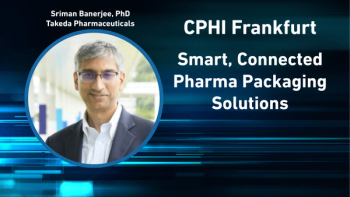
Equipment and Processing Report
- Equipment and Processing Report-01-20-2016
- Volume 9
- Issue 1
Trends in Parenteral Fill–Finish
Automation and ready-to-fill packaging formats are expected to grow in parenteral fill–finish operations.
Over the next five years, parenteral packaging will experience changes, including more pre-filled and ready-to-use containers, more efficient filling/closing operations, more automation, and more stringent quality requirements.
“A much larger share of production will be executed in smaller batch sizes driven by the requirement for specialty medication,” predicts Christian Treitel, director of Pharma Business Development, Bosch Packaging Technology, a manufacturer of packaging machines for pharmaceutical products. As a result, he says, “the [number] of pre-sterilized vials and cartridges in the market are expected to grow significantly and offer increased flexibility. We will also see the emergence of new and [currently] unknown pack styles combined with drug-delivery devices, which will be tailored to various patient groups.”
Driving forces for these changes include “the availability of new biotechnology products, patient comfort requirements, and [the development of] new therapies requiring specific features, such as pre-filled syringes, single-use vials, and IV premixed bags,” notes Frédéric Kahn, global vice-president Key Account Management at Gerresheimer, a supplier of glass and plastic packaging.
Increasingly, material choices will involve newer polymers such as cyclic olefin copolymer (COC) and hybrid constructions. Gerresheimer’s MultiShell vials, for example, deliver high barrier properties, clarity, and break resistance using a triple-layer structure that sandwiches a layer of polyamide between COC layers. Another new technology is the COC/glass container offered by Wheaton. According to Wayne Brinster, president and CEO of Wheaton, “This breakthrough will allow us to provide products that have the best of both worlds: the lightweight, break-resistant properties of plastic, with the barrier qualities and inert inner surface of pure glass….There are applications where having both materials in one product has long been needed.” Benefits of a glass interior include the elimination of extractables and leachables that could contaminate contents, plus a surface with lower vapor transmission and higher resistance to solvents. The plastic exterior protects the glass from cracking and breakage (1).
Vial filling
The trend toward ready-to-use containers is likely to drive changes in the production and filling of small-volume vials, currently the most common packaging format for parenteral products. Aseptic Technologies, for example, has introduced the Crystal Closed Vial and customized filling line. Already in use worldwide, the vial is aseptically molded and closed under ISO-5 conditions, irradiated, and delivered to the filling site. Vials sizes include 1, 2, 6, 10, 20, and 50 mL. The design maintains closure integrity at low temperatures, making the package well suited to cryogenic storage conditions (2).
The Crystal Filling line can be manual or fully automated and consists of three steps: filling through the thermoplastic elastomer stopper, laser resealing of the stopper, and snap-fit capping. The streamlined filling process requires less cleanroom space and eliminates the need for water for injection, vial and stopper washing, vial and stopper sterilization, stoppering, and capping by crimping (2).
Filling line options include the Crystal M1 manual filling station for batches of less than 1500 1-mL vials; the Crystal L1 Robot line; and the Crystal PX filling line. The single-robot L1 line, rated at 10 vials per minute, handles nests of closed vials and can be configured for ready-to-fill glass vials and syringes. The faster PX line delivers a maximum output of 180 vials per minute, can be equipped with up to eight pumps, offers 100% in-process control, and occupies a footprint of 16 m2 (2).
More automation
“As biologics mature in the drug development pipeline, we see an increase in complex manufacturing requirements,” says Kahn. In addition, he says, as markets and customers become more demanding, ready-to-use formats will experience growth. “Therefore,” he predicts, “parenteral packaging equipment/lines will become more automated and integrated, including ever more sophisticated quality control systems.”
“Quality requirements for glass containers are likely to be tightened further and include specifications regarding the particle load, lower rate of cracks or cosmetic defects, and smaller dimensional tolerances,” says Kahn. “Prefillable syringes are associated with specific requirements such as low hold-up volumes and reduced tungsten or siliconization levels. A recent Parenteral Drug Association Congress revealed that risk-based approaches to quality control are an important tool and should be implemented with competence.”
Treitel agrees that demand for automation and integration will rise. He says, “Price pressure due to generics and biosimilars will press large-scale parenteral manufacturing to become more efficient.”
Automation technologies include robotics, machine vision, servo-motors and drives, and an ever-increasing array of sensors. Robots can perform many material handling functions on parenteral packaging lines. “The incorporation of robotics into various functions will continue to evolve, specifically as it pertains to material handling within fill/finish and downstream packaging applications,” predicts Randy Fraatz, business development manager for MG America, the US subsidiary of MG2 of Bologna, Italy, a supplier of processing and packaging equipment.
With the evolution of collaborative robots that can work safely alongside human operators, Kahn predicts utilization will continue to rise and “further improve quality and safety especially in manipulation of high toxicity parenteral drugs fill and finish.”
Product quality also will be supported by isolator integrations. Fraatz believes the transition to isolators will continue. He predicts adoption of isolators “will lead to operational changes and some paradigm shifting for those organizations that are not familiar with isolator technology, but still need to remain competitive and demonstrate risk-reduced packaging processes for industry acceptance.”
“As the physical mechanics and materials change for both sterile and non-sterile parenteral applications, such as the use of robotics…or advancements in machinery design for single-use filling systems, it is important to recognize the changes in software programming and electronic controls that will be necessary for efficient machine operation. Packaging machinery will continue to change in ways that rely on software automation designs that can manage the command and control required as the data input/output progressively increases,” Fraatz concludes.
References
- Wheaton, “WHEATON to Commercialize Breakthrough Technology Providing Plastic Components with Pure Glass Interiors,” News Release, July 27, 2015.
- Aseptic Technologies, “Filling Solutions,” Internal Presentation, September 2015.
Articles in this issue
almost 10 years ago
Advancing Container Closure Integrity Testingalmost 10 years ago
Pharmaceutical Manufacturers Go GreenNewsletter
Get the essential updates shaping the future of pharma manufacturing and compliance—subscribe today to Pharmaceutical Technology and never miss a breakthrough.




